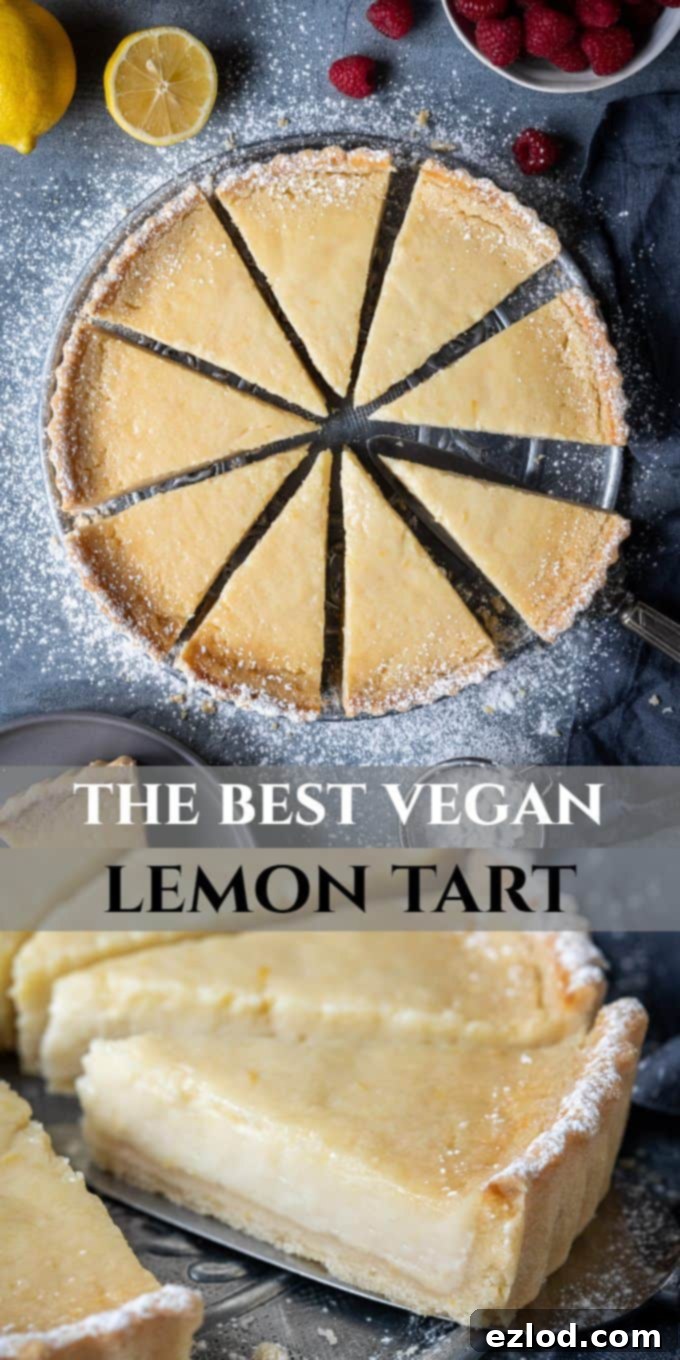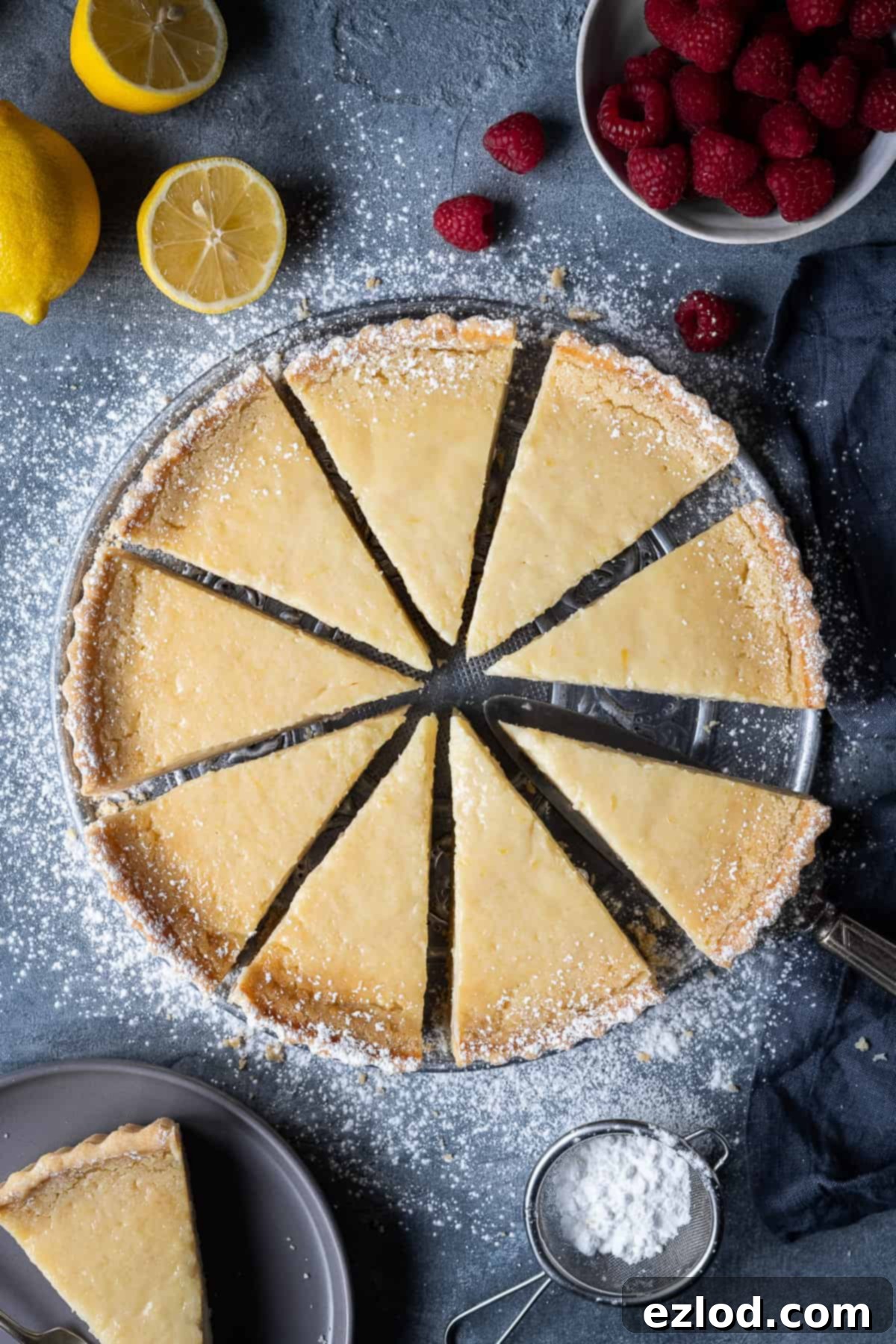The Ultimate Vegan Lemon Tart: Tangy, Creamy & Perfectly Baked (Dairy-Free & Eggless Classic!)
Discover the magic of this vegan lemon tart – a dairy-free and eggless rendition of the beloved classic tarte au citron. Prepare for a dessert that’s intensely lemony, wonderfully tangy, luxuriously creamy, and utterly irresistible. Featuring a perfectly crisp pastry shell cradling a silky, baked lemon custard, you’ll be amazed that it contains no animal products whatsoever!

For years, the classic lemon tart, or tarte au citron, stood as one of my absolute favourite desserts. Its bright, zesty flavour and smooth, custardy texture were unmatched. However, after transitioning to a vegan lifestyle, I found myself longing for this beloved treat, knowing that the traditional recipe relies heavily on eggs, cream, and butter – ingredients typically off-limits in a plant-based diet. Recreating such a delicate balance without these staples seemed like a formidable challenge, but my determination to craft an authentic vegan version was unwavering.
Through countless experiments and a few delightfully lemony (but not quite perfect) tart iterations, I meticulously refined my approach. My prior success in using silken tofu as a versatile egg replacer in various recipes proved invaluable, and it truly shone in this quest. After careful adjustments to the ingredient ratios and baking times, I finally achieved a breakthrough. The result is a vegan lemon tart that, to my palate, mirrors the exquisite taste and texture I cherished from my pre-vegan days. It boasts an intensely lemony flavour that brightens the senses, a beautifully smooth and creamy filling, and a delightfully crisp, golden pastry shell. This elegant dessert is versatile enough for any occasion, from a casual family gathering to a sophisticated dinner party.
Unlike some lemon tart recipes that involve cooking the filling on the stovetop and then chilling it to set, this recipe features a baked vegan lemon custard. While a stovetop method (similar to making lemon curd) is certainly an option and can yield delicious results, I firmly believe that baking the filling in the pastry shell creates a superior texture – richer, more custardy, and with a delightful slight ‘give’ that truly elevates the experience. This method ensures a perfectly integrated tart, where the crust and filling bake in harmony.
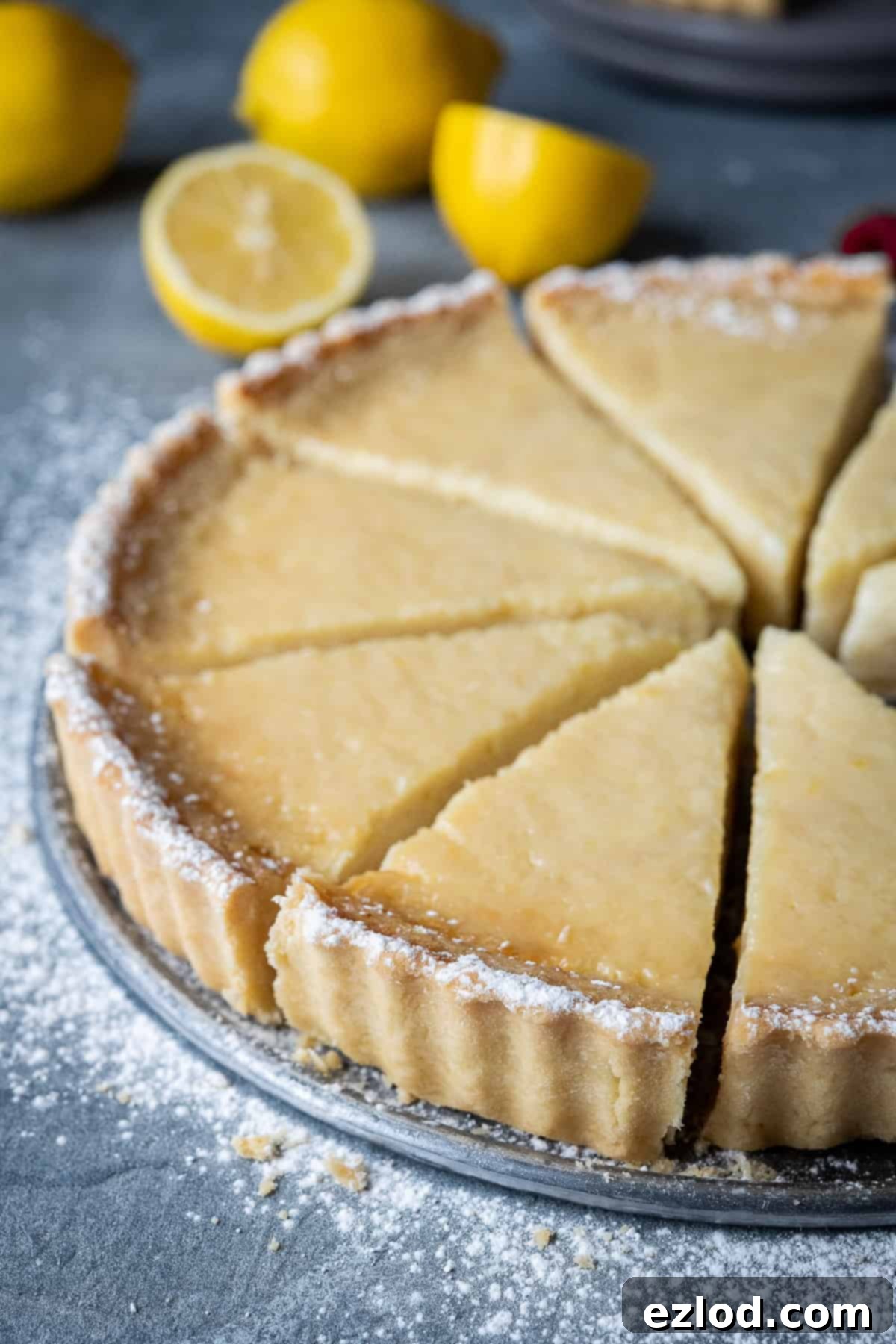
Essential Ingredients for Your Perfect Vegan Lemon Tart
Crafting this exceptional vegan lemon tart requires a few key plant-based ingredients that expertly replace their traditional counterparts while delivering on flavour and texture. Here’s a closer look at what you’ll need to create this dairy-free and eggless masterpiece:
What Do I Need To Make Vegan Lemon Tart?
- Silken Tofu: This is arguably the most crucial ingredient for achieving the signature creamy, custardy texture without eggs. Silken tofu is incredibly smooth and, when blended, becomes a neutral base that takes on the bright lemon flavour beautifully. It’s important to use firm silken tofu, not regular block tofu, as its higher water content and delicate consistency are essential for the desired custard-like result. Unfortunately, there isn’t a direct substitute that will yield the exact same texture, so don’t skip this one!
- Coconut Cream: Stepping in for the heavy or double cream found in non-vegan recipes, coconut cream provides richness and body to the filling. You can purchase it in cartons (like the Blue Dragon brand), or you can scoop the thick, solid white part from a can of full-fat coconut milk that has been thoroughly chilled overnight. Always aim for the thick, creamy solids rather than the clear liquid for the best results. If coconut is not your preference, or you have access to specific vegan alternatives, excellent substitutes include soy cream, oat cream, or cashew cream. In the UK, Elmlea Plant Double cream (ensure it’s the double, not single) works perfectly and yields a very similar outcome.
- Cornflour (Cornstarch): This humble ingredient plays a vital role in thickening and setting the lemon filling, replacing the binding properties of eggs. It ensures your tart holds its shape beautifully once baked and chilled. While arrowroot powder might be a possible substitute, I have not extensively tested it, so cornflour is the recommended choice for guaranteed success.
- Caster Sugar: Either fine caster sugar or regular granulated sugar will work effectively in this recipe. Sugar not only provides sweetness but also contributes to the filling’s structure and mouthfeel. I highly advise against using liquid sweeteners such as maple syrup or agave nectar, as their additional moisture content and different chemical properties can significantly affect the tart’s setting and final texture, potentially leading to a runny filling.
- Fresh Lemon Juice and Zest: For an intensely vibrant and authentic lemon flavour, fresh lemons are absolutely essential. While bottled lemon juice can be used in a pinch, it simply doesn’t capture the bright, complex, and aromatic notes that freshly squeezed juice and finely grated zest provide. The zest, in particular, carries most of the lemon’s essential oils, adding a concentrated burst of flavour and aroma.
- Vegan Butter/Margarine: A touch of melted vegan block butter or margarine is added to the filling to enhance its creaminess and richness, contributing to a truly decadent taste. I experimented with omitting it, but found that its inclusion significantly improves both the flavour profile and the structural set of the tart, making it a recommended addition. You’ll also need a good quality vegan block butter for the pastry for a crisp and flaky crust.
- Ground Turmeric: This is an entirely optional ingredient, included solely for aesthetic purposes. A very small pinch of ground turmeric can impart a beautiful, subtle lemony yellow hue to the filling, mimicking the colour that egg yolks would typically provide. Be cautious not to overdo it, as the tart’s colour will naturally deepen slightly as it bakes. You want just a whisper of colour, not an overpowering turmeric flavour.
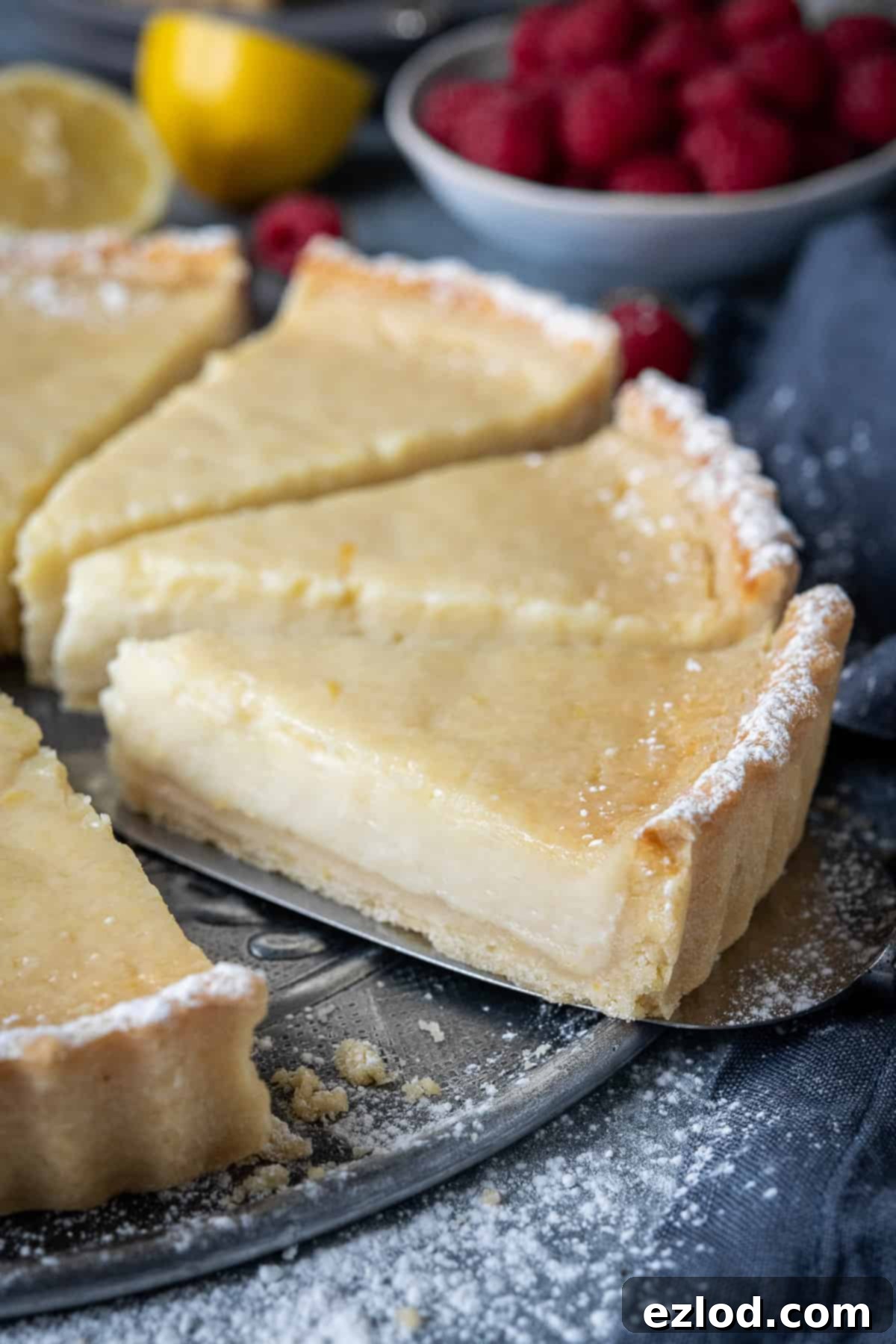
How To Make The Ultimate Vegan Lemon Tart: A Step-by-Step Guide
Creating this stunning vegan lemon tart is a rewarding process that combines careful technique with simple ingredients. Follow these detailed steps to achieve a perfectly crisp crust and a lusciously creamy, tangy filling. (For a complete list of ingredients with precise measurements and full instructions, please refer to the recipe card below.)
Step 1: Prepare Your Flaky Vegan Pastry
Begin by making the pastry. In a large mixing bowl, combine the plain (all-purpose) flour, icing (powdered) sugar, and salt. Whisk these dry ingredients together thoroughly, or if using a food processor, pulse them until well combined. Next, add the cold, diced vegan block butter. Using your fingertips, rub the butter into the flour mixture until it resembles fine breadcrumbs, ensuring no large lumps of fat remain. If using a food processor, pulse until a similar consistency is achieved. Incorporate one tablespoon of cold vodka (or water if preferred). Gradually drizzle in a small amount of additional cold water, just enough to bring the pastry dough together into a cohesive ball. Be careful not to add too much liquid. Once formed, flatten the dough slightly, cover it tightly, and refrigerate for at least 30 minutes. This chilling period is crucial for firming up the butter and allowing the gluten to relax, which will result in a flakier, easier-to-handle crust.
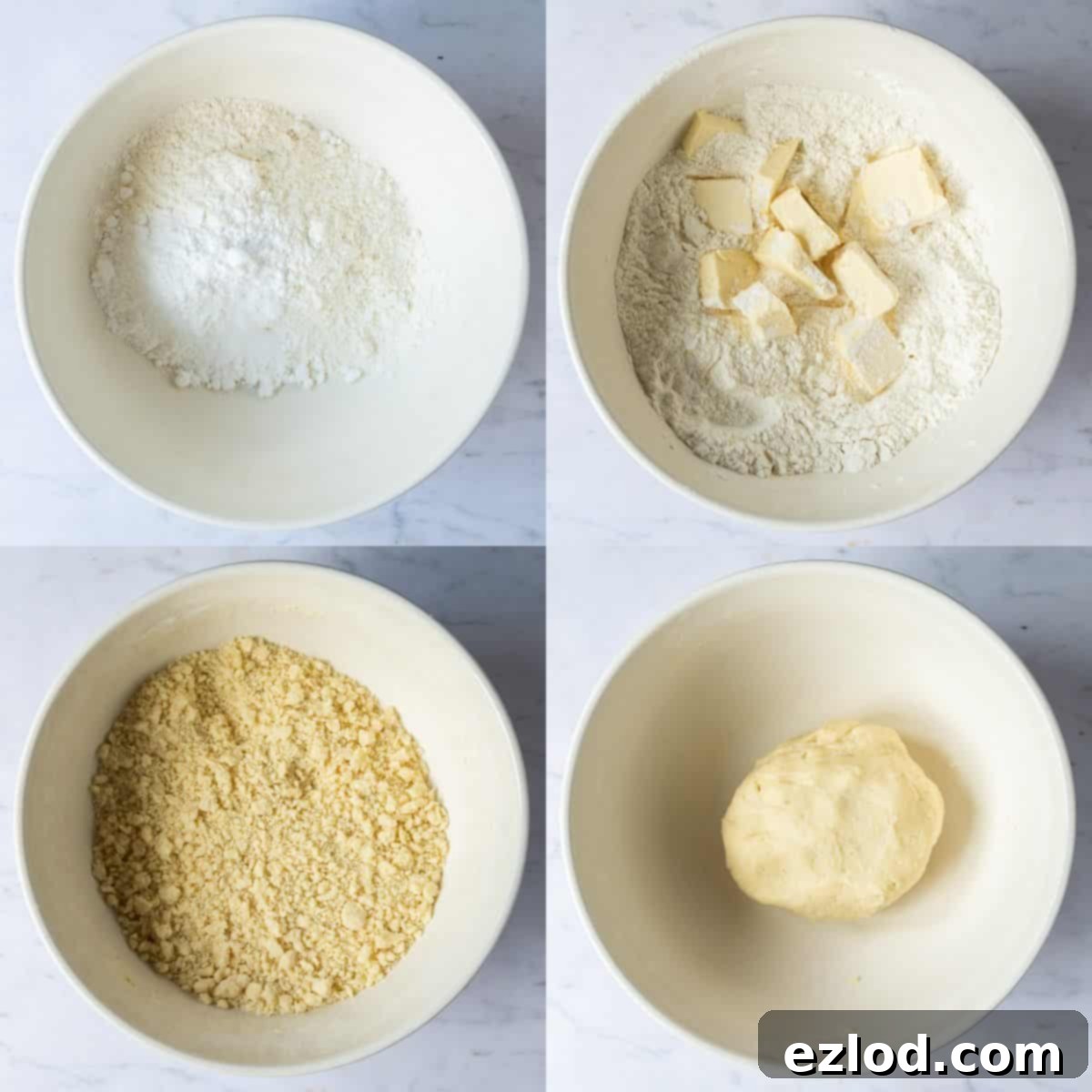
Step 2: Roll and Chill the Pastry Shell
Once your pastry has adequately chilled, lightly flour a clean work surface. Roll out the dough thinly and evenly until it’s large enough to comfortably line a 25cm (10-inch) round tart tin. Carefully transfer the rolled pastry into your tart tin, gently pressing it into the base and up the sides, ensuring it fits snugly into all the corners. Use a sharp knife to trim away any excess pastry from the edges. Finally, prick the base of the pastry shell all over with a fork. This step helps prevent the crust from puffing up during blind baking. Place the prepared pastry base into the freezer for 20 minutes while your oven preheats to 200°C/180° fan/400°F/gas mark 6. The cold temperature will help the pastry maintain its shape and crispness.
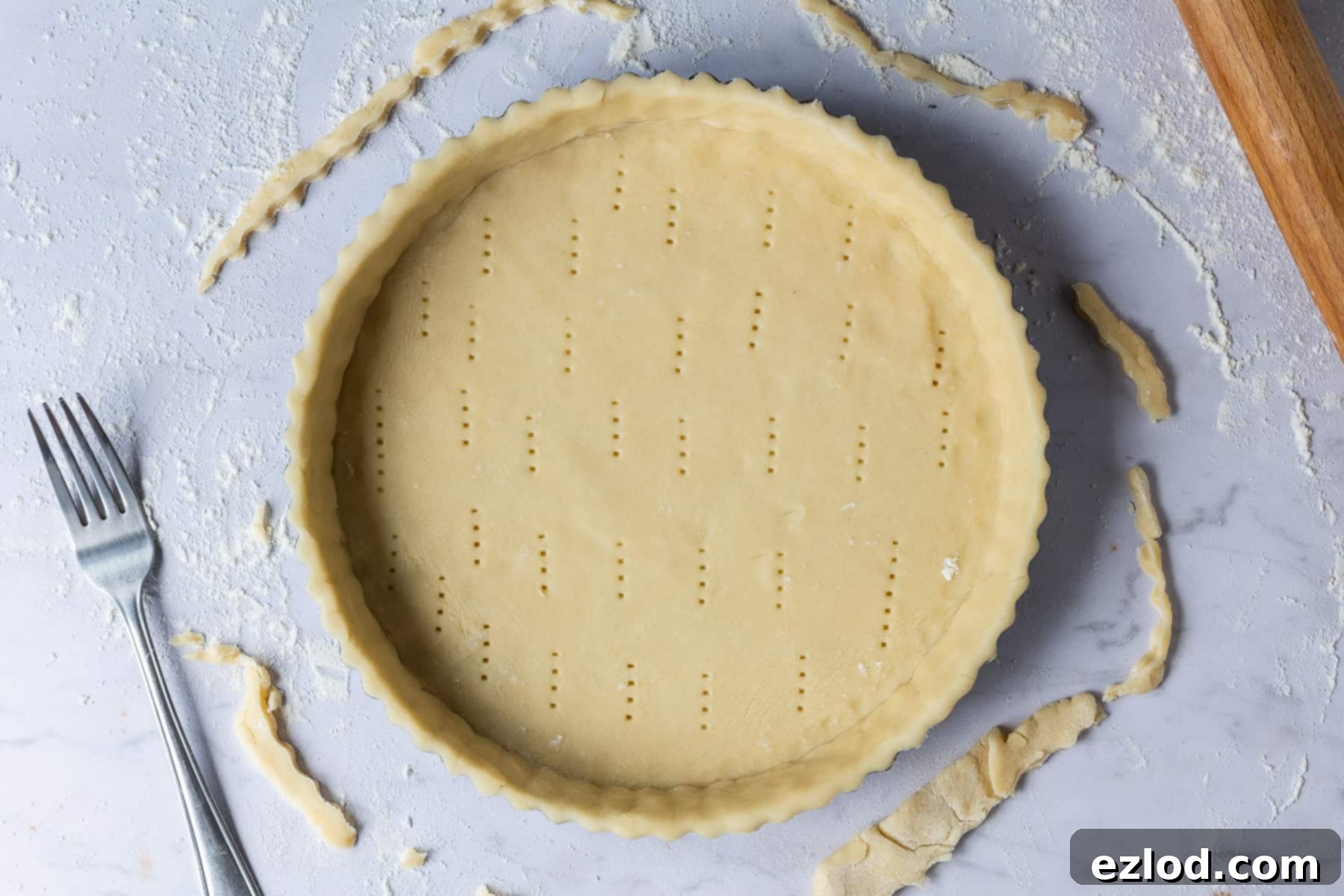
Step 3: Blind Bake the Pastry for a Crisp Base
When the pastry shell is firm and thoroughly chilled from the freezer, it’s time for blind baking. Line the pastry with a sheet of tin foil or parchment paper, ensuring it’s pressed firmly into the corners of the tin. Fill the lined pastry shell with baking beans or dried rice. These weights will prevent the pastry from shrinking and help it bake evenly. Bake in the preheated oven for 20 minutes. After this initial bake, carefully remove the tin foil and baking weights. Return the tart shell to the oven for another 10-15 minutes, or until it appears pale golden and feels crisp to the touch. Once baked, reduce the oven temperature to 180°C/160° fan/350°F/gas mark 4, ready for the filling. This two-stage blind baking ensures a sturdy, perfectly cooked base that won’t get soggy from the wet filling.
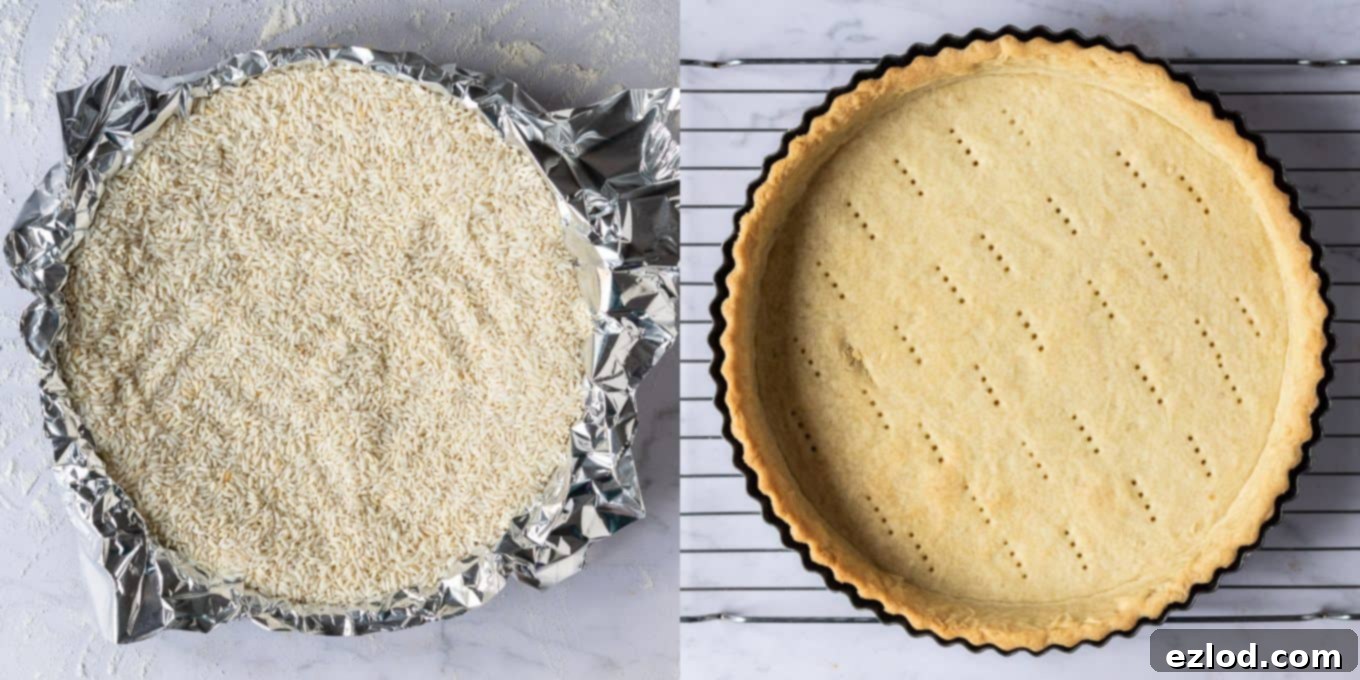
Step 4: Craft the Creamy Lemon Filling
While your pastry shell is blind baking, prepare the luscious lemon filling. In a high-speed blender, combine the fresh lemon juice, firm silken tofu, thick coconut cream, cornflour (cornstarch), caster or granulated sugar, melted vegan block butter, and an optional tiny pinch of ground turmeric (for a sunny yellow colour). Blend these ingredients until the mixture is completely smooth and uniform, scraping down the sides of the blender as needed to ensure everything is fully incorporated. Once smooth, remove the blender jar and gently stir in the finely grated lemon zest. This ensures the vibrant lemon flavour and aromatic oils from the zest are preserved and not over-processed.
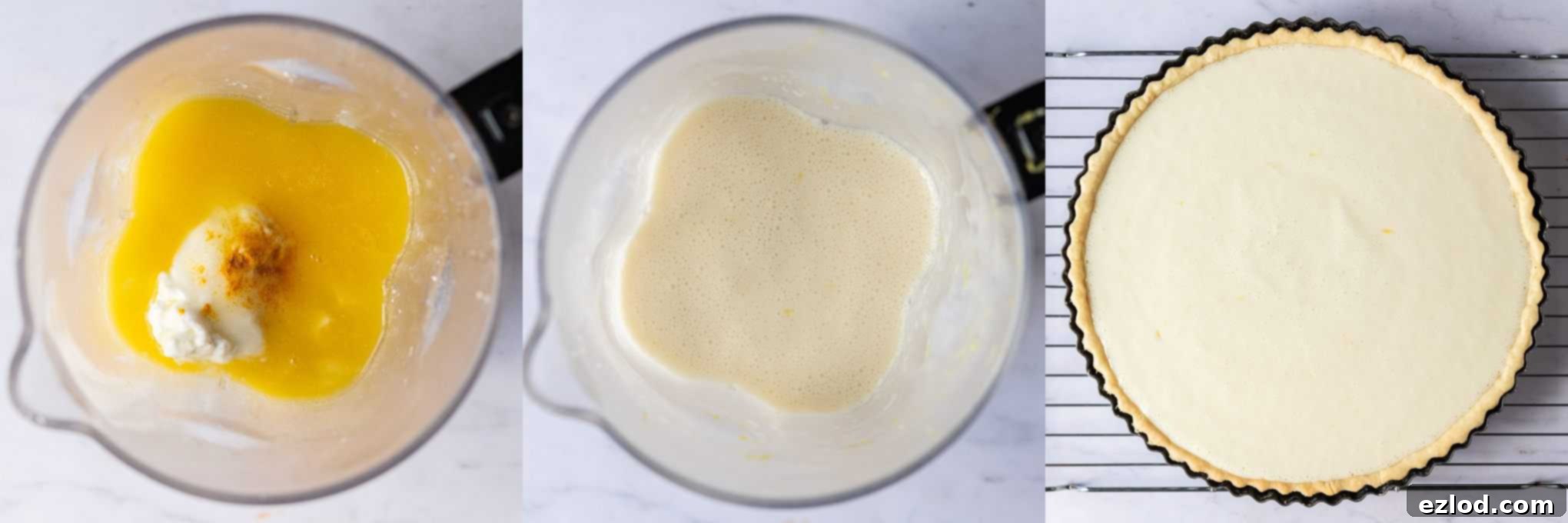
Step 5: Bake, Cool, and Chill for Perfection
Once your blind-baked pastry case is ready, carefully pour the prepared lemon filling into the warm shell. Gently transfer the tart back into the preheated oven (now at the lower temperature of 180°C/160° fan/350°F/gas mark 4). Bake for 30-40 minutes. The tart is done when the edges appear set, but the centre still has a slight, delicate wobble. This indicates a perfectly cooked, creamy custard. Remove the tart from the oven and allow it to cool completely at room temperature on a wire rack. Patience is key here, as rushing this step can lead to cracking. Once fully cooled, transfer the tart to the refrigerator and chill for a minimum of 4 hours, though overnight is ideal, to allow the filling to set completely and achieve its ultimate creamy texture. Serve cold and enjoy!
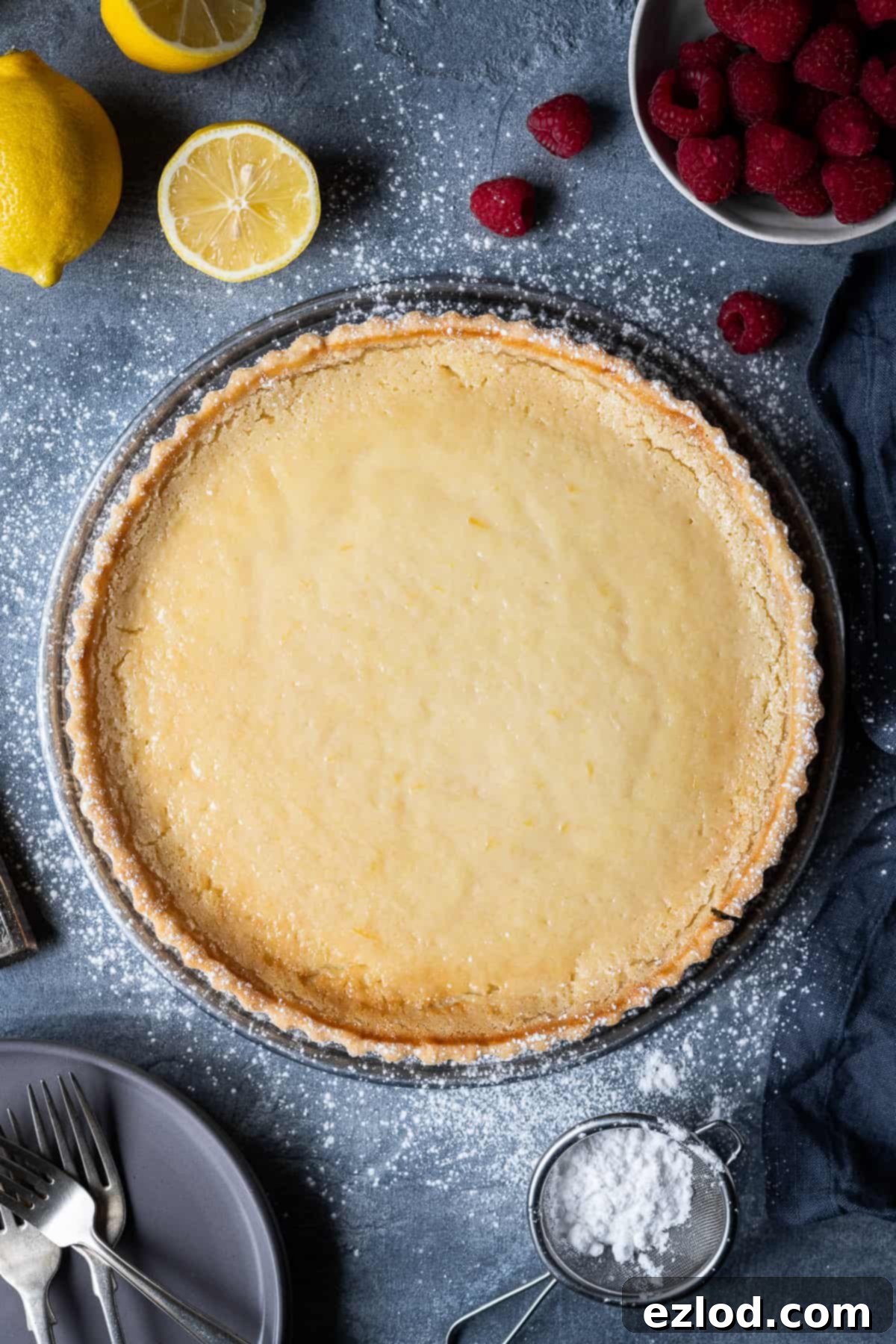
Top Tips for Vegan Lemon Tart Success
Achieving a truly exceptional vegan lemon tart relies on attention to detail and a few key techniques. Here are my top tips to ensure your dessert turns out perfectly every time:
- Precision in Measurements: For the absolute best results in baking, I cannot stress enough the importance of weighing your ingredients using gram measurements and a digital scale. Cup measurements can be highly inconsistent and may lead to varying outcomes, especially with delicate recipes like this one. Accurate measurements are the foundation of successful baking.
- Choosing the Right Tofu: Always use firm silken tofu, not regular block tofu. Silken tofu is typically found in shelf-stable aseptic cartons, often in the ‘Asian’ section of supermarkets (near soy sauce) or alongside tinned beans. Brands like Mori-Nu or Clearspring are excellent choices. Remember to drain off any excess liquid from the tofu, but there’s no need to press it as you would with regular tofu.
- The Best Vegan Butter for Pastry: For a truly crisp and flaky pastry, it is imperative to use a vegan block butter/margarine. These come in foil-wrapped blocks and have a lower water content, making them ideal for baking. Avoid spreadable vegan margarines or butters that come in tubs, as their higher water content will make your pastry soft and difficult to work with. Popular UK brands include Naturli Vegan Block, Stork block, Vitalite, or Tormor blocks (again, ensure they are block versions).
- Handling Pastry Like a Pro: To achieve that perfect, crisp pastry, avoid overworking the dough, which can develop gluten and make it tough. Also, prevent the pastry from getting too warm; cold butter is key to flakiness. Freezing the tart shell for 20 minutes before blind baking is a brilliant trick to help the pastry hold its shape, prevent shrinkage, and ensure a truly crisp base.
- The Vodka Secret for Crispness: Adding a tablespoon of cold vodka instead of solely relying on water to bind the pastry helps immensely with crispness. Vodka has a lower water percentage and the alcohol evaporates quickly during baking, resulting in a more tender and flaky crust. Don’t worry, you won’t taste the vodka in the finished tart! If you prefer not to use it, cold water will still work, but the vodka offers an extra edge.
- Patient Cooling Prevents Cracks: Once the tart comes out of the oven, allow it to cool completely at room temperature before moving it to the refrigerator. Rapid temperature changes can cause the delicate filling to crack. While a slight crack might still occur, it in no way affects the incredible flavour or texture.
- The Power of Chilling: For the best set and most delightful texture, this vegan lemon tart truly benefits from ample chilling time. Ideally, prepare it the day before you plan to serve it, allowing it to chill in the fridge for at least four hours, or even better, overnight. This extended chilling ensures the custard is perfectly firm and creamy.
- Versatile Filling: The versatile lemon filling recipe for this tart isn’t limited to just tarts! You could also use it as a base for vegan lemon meringue pie (paired with a vegan meringue) or to create delicious lemon bars.
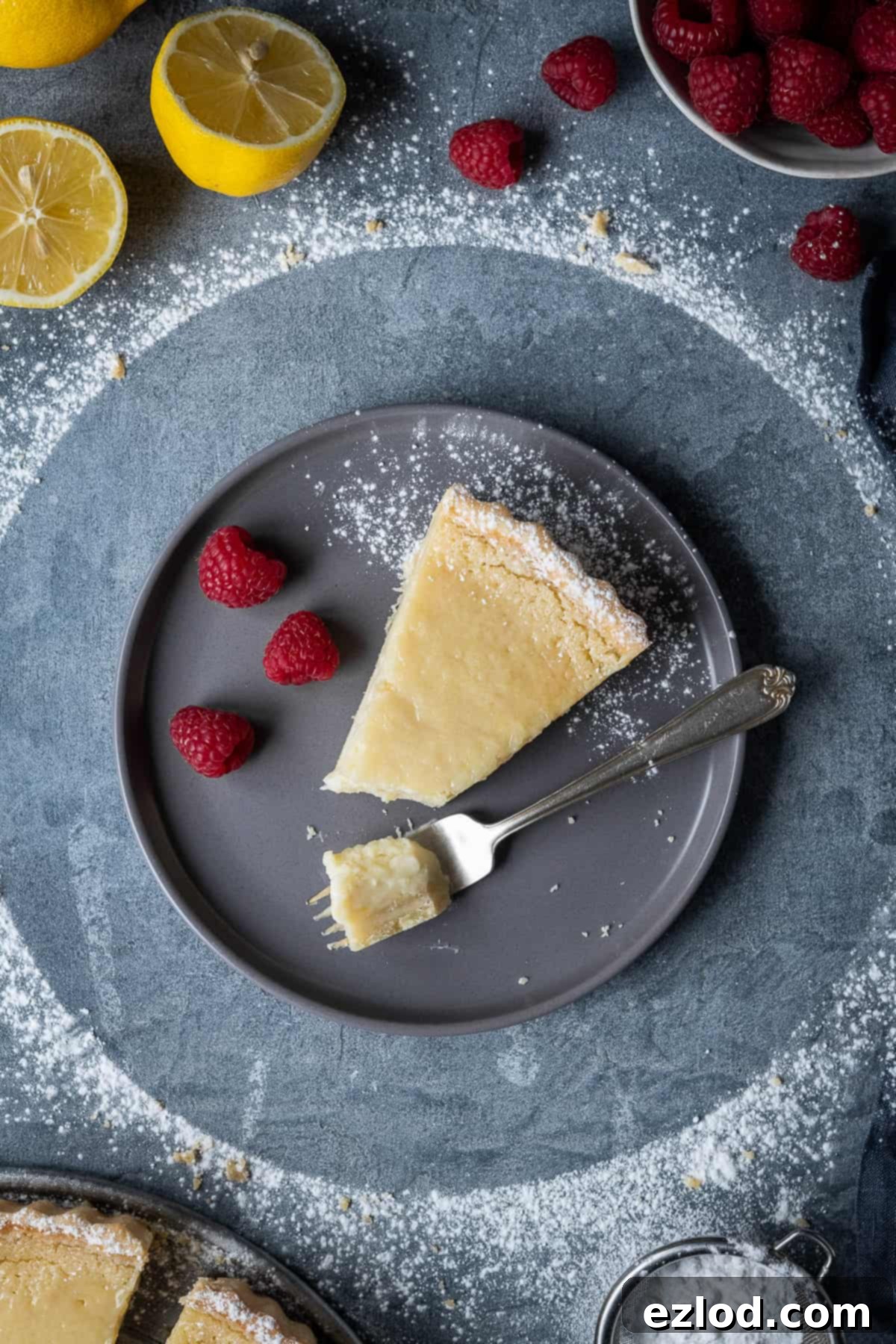
Serving Suggestions for Your Vegan Lemon Tart
This exquisite vegan lemon tart is a showstopper all on its own, but a few simple additions can elevate its presentation and taste even further. Dust lightly with a fine layer of powdered (icing) sugar just before serving for an elegant finish. A scattering of fresh berries, particularly vibrant raspberries or blueberries, adds a beautiful contrast in colour and a burst of complementary flavour. For an extra touch of indulgence, a dollop of vegan whipped cream or a scoop of vegan vanilla ice cream makes a perfect accompaniment. This tart is ideal for afternoon tea, a sophisticated dessert at a dinner party, or simply as a special treat to brighten any day.
Can I Freeze This Vegan Lemon Tart?
Yes, absolutely! This vegan lemon tart freezes beautifully. Any leftover slices or even the whole tart (if you plan ahead!) can be stored in an airtight container in the freezer for up to three months. When you’re ready to enjoy it, simply transfer the tart to the refrigerator and allow it to defrost slowly overnight, or for at least several hours, before serving. This gentle thawing helps maintain the creamy texture of the filling.
Frequently Asked Questions About Vegan Lemon Tart
Q: Can I use bottled lemon juice instead of fresh?
A: While bottled lemon juice will work, the flavour will not be as vibrant or complex as that from fresh lemons. For the best possible taste, fresh is highly recommended. The zest also adds crucial aromatic oils that bottled juice lacks.
Q: My tart cracked when cooling, what went wrong?
A: Cracking can sometimes occur due to rapid temperature changes, especially if the tart is moved directly from a warm oven to a cold refrigerator. Allowing it to cool completely at room temperature before chilling helps minimize this. A slight crack doesn’t affect the taste or texture at all!
Q: Can I make this tart gluten-free?
A: To make this tart gluten-free, you would need to use a high-quality gluten-free plain flour blend for the pastry. Ensure the blend contains xanthan gum for structure, or add ½ tsp if it doesn’t. The filling itself is naturally gluten-free.
Q: How long does the vegan lemon tart keep in the fridge?
A: Once chilled, the vegan lemon tart can be stored covered in the refrigerator for up to 3-4 days. The flavour often improves slightly on the second day!
More Delicious Vegan Tarts And Pies To Explore
If you’ve fallen in love with this vegan lemon tart, you might enjoy exploring other plant-based pastry delights:
Vegan Bakewell tart
Vegan pumpkin pie
Blueberry frangipane tarts
Vegan strawberry tart with coconut pastry cream
No-bake chocolate stem ginger tart
Blueberry pie with coconut oil crust
Starry mince pie tart
Mini vegan apple pies
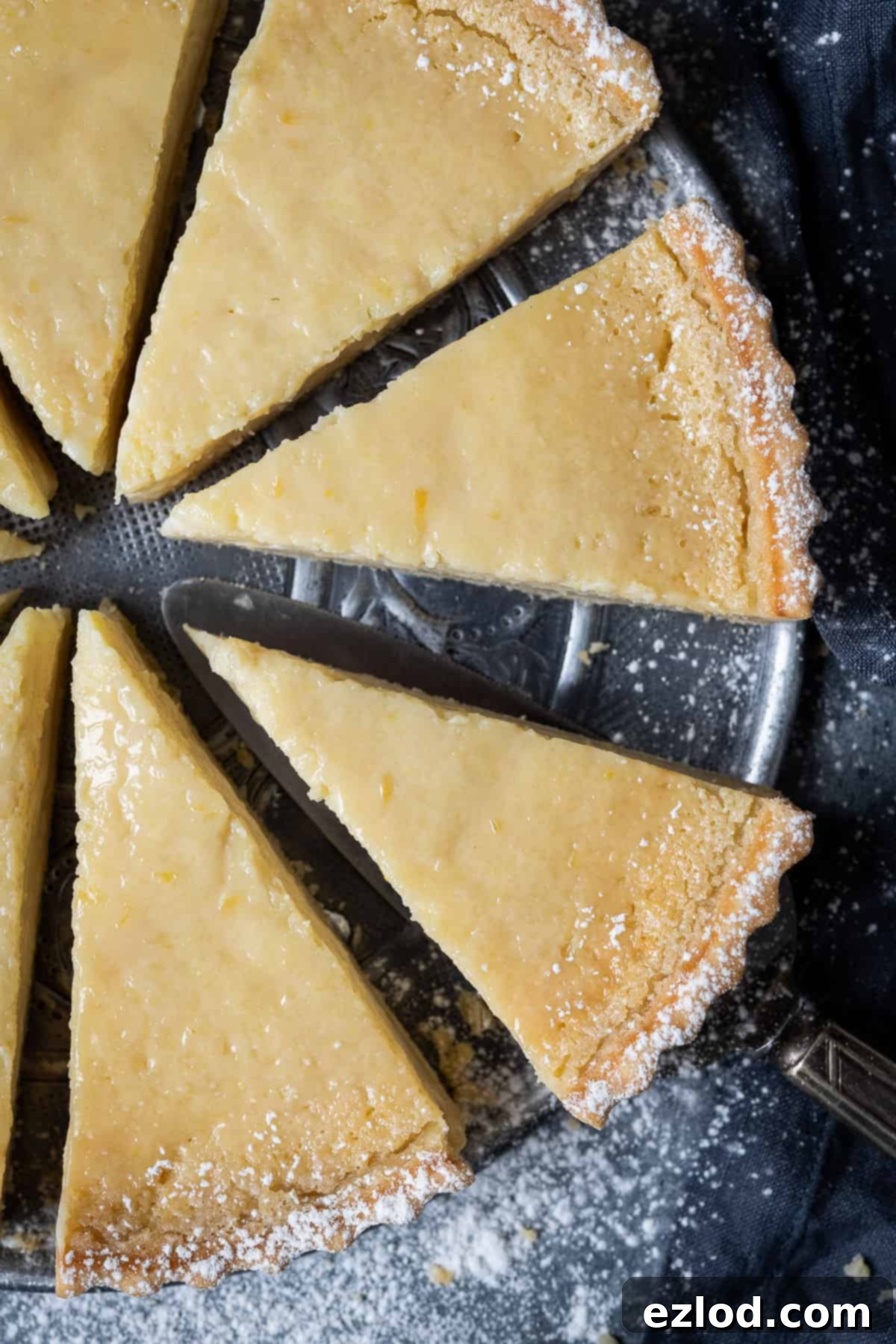
If you tried this incredible vegan lemon tart recipe, we’d love to see it! Why not tag @domestic_gothess on Instagram and use the hashtag #domesticgothess to share your creation?
*All images and content on Domestic Gothess are copyright protected. If you want to share this recipe then please do so by using the share buttons provided. Do not screenshot or post the recipe or content in full.*

Print
Vegan Lemon Tart
Ingredients
Pastry:
- 250 g (2 cups) plain (all-purpose) flour
- 50 g (⅓ cup + 1 Tbsp) icing (powdered) sugar
- ¼ tsp salt
- 150 g (5 ⅓ oz / ½ cup + 2Tbsp) vegan block butter/margarine (NOT the spreadable kind. I use Naturli vegan block) cold and diced
- 1 Tbsp cold vodka (optional)
- ice water as needed
Filling:
- finely grated zest of 2 lemons
- 250 ml (1 cup) fresh lemon juice (from about 5-6 lemons)
- 225 g (8 oz) firm silken tofu (not regular tofu)*
- 180 g (¾ cup) coconut cream**
- 50 g (5 packed Tbsp) cornflour (cornstarch)
- 200 g (1 cup) caster or granulated sugar
- 50 g (1 ¾ oz / scant ¼ cup) vegan block butter/margarine ( I use Naturli Vegan Block) melted
- a pinch of ground turmeric (optional, for colour)
Instructions
-
Start by making the pastry. Place the plain flour, icing sugar and salt in a large bowl and whisk to mix or place in a food processor and pulse until combined.
-
Add the cold diced vegan block butter and rub it in using your fingers or blend with the food processor until the mixture resembles fine breadcrumbs and no lumps of fat remain.
-
Add the tablespoon of cold vodka (or water) and mix; drizzle in a little cold water as needed to bring the pastry together into a ball.
-
Cover the pastry and pop it in the fridge for half an hour until it has firmed up a bit.
-
Once the pastry has chilled, roll it out thinly on a floured surface until it is large enough to line a 25cm/10 inch round tart tin.
-
Gently transfer the pastry to the dish and press it right into the corners. Trim off the excess pastry and prick the base all over with a fork.
-
Place the pastry base in the freezer for twenty minutes while you preheat the oven to 200°C/180° fan/400°F/gas mark 6.
-
When the pastry is nice and cold, line it with tin foil, making sure that you press it right into the corners, then fill it with baking beans or dried rice. Make sure you spread them right into the corners.
-
Bake for 20 minutes then remove the tin foil and rice/beans and return the tart shell to the oven for 10-15 minutes, until it is pale golden and crisp. Turn the oven down to 180°C/160° fan/350°F/gas mark 4.
-
While the pastry is baking prepare the filling. Place the lemon juice, silken tofu, coconut cream, cornflour, sugar, melted butter and a pinch of ground turmeric in a blender and blitz until completely smooth, scraping down the sides as necessary. Stir in the lemon zest.
-
When the pastry case has finished baking, carefully pour in the filling and place it back in the oven.
-
Bake for 30-40 minutes until the filling is set but still has a wobble. Remove from the oven and allow it to cool completely before refrigerating. Once cool, chill the tart for at least 4 hours before serving.
Notes
- For the best results make sure that you follow the recipe closely. As always, I highly recommend weighing your ingredients using the gram measurements (with a digital scale), rather than the cup conversions. Cup measurements are simply not accurate enough for baking and I cannot guarantee the best results if you use them.
- *You need to use firm silken tofu, NOT regular tofu. It is most commonly the shelf-stable kind, not the fridge kind. In the UK it can usually be found either in the ‘Asian’ section of the supermarket (by the soy sauce), or next to the tinned beans. I use Mori-Nu or Clearspring.
- **I use coconut cream from a carton (Blue Dragon brand, use only the solid white part) but you can also use just the solid white part from a tin of chilled full-fat coconut milk. The coconut cream can be swapped for Elmlea Plant double cream or a soy/oat/cashew cream.
- Ideally you should make this vegan lemon tart the day before you want to serve it as it needs to chill in the fridge for at least four hours, preferably longer.
Pin for later:
